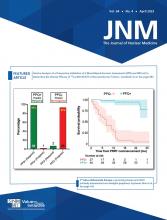Discussions with leaders: Buvat and Weber test ChatGPT’s familiarity with nuclear medicine knowledge and practice in an extended virtual conversation.
Page 505
Chemotherapy and cognitive impairment: Chiaravalloti and colleagues summarize brain imaging findings relevant to subsequent cognitive effects in patients undergoing chemotherapy for common oncologic diseases.
Page 508
PET imaging in vasculitis: Slart and colleagues provide an educational overview of the diagnostic role of 18F-FDG PET/CT in patients with large-vessel vasculitis, medium-sized vessel vasculitis, and polymyalgia rheumatica.
Page 515
PRRT and NETs: Hindié and colleagues offer a brief review of the latest advances in peptide-receptor radionuclide therapy of neuroendocrine tumors of gastroenteropancreatic origin, including clinical trial results and promising combination therapies.
Page 522
AUC summary for lymphoscintigraphy: Donohoe and members of a collaborative work group summarize the key points of appropriate use criteria (AUC) developed for lymphoscintigraphy in sentinel lymph node mapping and in lymphedema, including clinical scenarios.
Page 525
Radioembolization in cholangiocarcinoma: Schaarschmidt and colleagues identify clinical and tumor-associated factors in improved median overall survival in patients with intrahepatic cholangiocarcinoma receiving radioembolization at 5 major tertiary-care centers.
Page 529
PET in large B-cell lymphoma: Michaud and colleagues assess the prognostic value of 18F-FDG PET/CT parameters at baseline, interim, and end of treatment in patients with diffuse large B-cell lymphoma.
Page 536
[177Lu]Lu-ofatumumab lymphoma therapy: Shim and colleagues report on in vitro studies, dosimetry, tumor targeting, and therapeutic efficacy with this radiolabeled human anti-CD20 antibody in a murine model of disseminated non-Hodgkin lymphoma.
Page 542
225Ac-MACROPATATE for NETs: King and colleagues detail the design and production of a novel radioconjugate capable of chelating 225Ac at room temperature and assess in vitro and in vivo studies of its potential for α-particle targeted peptide-receptor radionuclide therapy.
Page 549
89Zr-DFO-bexmarilimab PET: Moisio and colleagues evaluate a humanized monoclonal antibody against common lymphatic endothelial and vascular endothelial receptor-1 in a rabbit model of renal fibrosis.
Page 555
Thyroid remnant ablation in GO: Oeverhaus and colleagues report on responses after ablation of thyroid remnants with radioactive iodine therapy in patients with unstable Graves’ orbitopathy after subtotal thyroidectomy.
Page 561
PPQ/NETest validation for PRRT: Bodei and colleagues look at 2 predictive markers for response to and monitoring of peptide-receptor radionuclide therapy in neuroendocrine tumors and evaluate the predictive contributions of tissue-based genetic alterations.
Page 567
Sequencing 223Ra and 177Lu-PSMA: Rahbar and colleagues document safety and survival outcomes in patients with bone-predominant metastatic castration-resistant prostate cancer treated with 177Lu-PSMA after 223Ra therapy.
Page 574
18F-PSMA versus 18F-fluorocholine PET/CT: Olivier and colleagues compare 18F-PSMA-1007 PET/CT and 18F-fluorocholine PET/CT for localization of suspected biochemical recurrence of prostate cancer and for associated clinical management.
Page 579
18F-Fluciclovine PET-guided radiotherapy: Lawal and colleagues analyze data from the EMPIRE-1 study, which compared fluciclovine PET/CT and conventional imaging in guiding prostate cancer salvage radiotherapy, here stratifying by protocol-specified criteria and comparing failure-free rates.
Page 586
68Ga-PSMA11 and 68Ga-RM2 PET for HIFU: Duan and colleagues evaluate a novel approach using both 68Ga-RM2 and 68Ga-PSMA11 PET/MRI in patients with localized prostate cancer before and after high-intensity focused ultrasound therapy to assess target tumor localization and response to treatment.
Page 592
Translation of 18F-PSMA CLI and FAR CLI: Fragoso Costa and colleagues assess the value of Cerenkov luminescence imaging with flexible autoradiography and with 18F-PSMA-1007 in preclinical studies and in patients with high-risk prostate cancer.
Page 598
Systematic PSMA PET response assessment: Kind and colleagues analyze the suitability of a semiautomatic prognostic approach by comparing 18F-PSMA-1007 with 68Ga-PSMA-11 PET/CT data for prediction of overall survival in patients with prostate cancer before 177Lu-PSMA radioligand therapy.
Page 605
177Lu-EB-PSMA RLT in mCRPC: Wang and colleagues investigate the safety and therapeutic efficacy of radioligand therapy with 177Lu-EB-PSMA in patients with previously treated metastatic castration-resistant prostate cancer.
Page 611
68Ga-FAPI-46 at 3 time points: Naeimi and colleagues monitor uptake on PET at 10 min, 1 h, and 3 h after 68Ga-FAPI-46 administration in a spectrum of tumor types, with resulting implications for improving workflow and patient wait times.
Page 618
FAP-based PET imaging: Kashyap and Ravi Kumar review the current status and future promise of fibroblast-activation protein inhibitor–based imaging, including the ability to address specific limitations of 18F-FDG PET and to provide both new and complementary biologic insights.
Page 623
18F-FAPI-04 PET/CT response prediction in LA-ESCC: Hu and colleagues examine whether 18F-AlF-NOTA-fibroblast-activation protein inhibitor-04 PET/CT can predict short-term outcomes in patients with locally advanced esophageal squamous cell carcinoma treated with concurrent chemoradiotherapy.
Page 625
18F-AlF-OC versus 68Ga-DOTA-SSA PET: Pauwels and colleagues detail the results of a multicenter trial comparing the diagnostic performances of 18F- and 68Ga-labeled somatostatin analog PET tracers in patients with neuroendocrine tumors.
Page 632
Theranostic peptides targeting integrin αvβ6: Ganguly and colleagues describe development and testing of a novel αvβ6-targeting peptide, 68Ga-DOTA-5G, and its DOTA-albumin-binding moiety for PET/CT imaging and with 177Lu labeling for treatment.
Page 639
Myocardial efficiency in mitral regurgitation: Sorensen and colleagues use 11C-acetate PET to noninvasively measure myocardial mechanical external efficiency, the energetic ratio of external cardiac work and left ventricular oxygen consumption.
Page 645
Deep learning for CAC on SPECT/CT: Miller and colleagues evaluate CT attenuation correction quantification derived from SPECT/CT myocardial perfusion maps using a deep learning model, including correlation with expert annotations and associations with major adverse cardiovascular events.
Page 652
Spatial normalization with deep learning: Kang and colleagues present a novel method for automatic quantification of amyloid PET using deep learning–based spatial normalization of PET images, which does not require MR or CT images of the same patient.
Page 659
CXCR4 expression in meningioma: Krebs and colleagues report on a clinical experience detecting C-X-C chemokine receptor 4 expression in meningioma with 68Ga-pentixafor PET.
Page 667
- © 2023 by the Society of Nuclear Medicine and Molecular Imaging.







